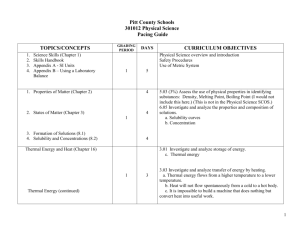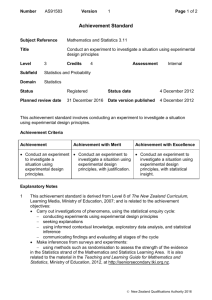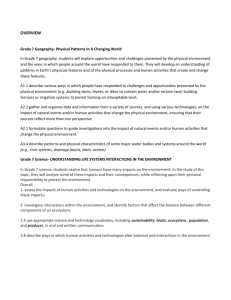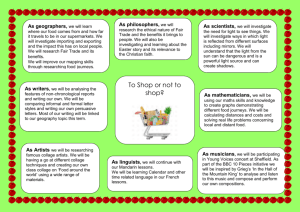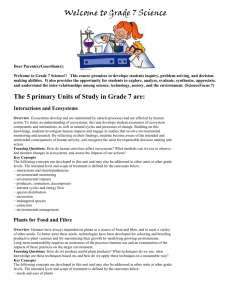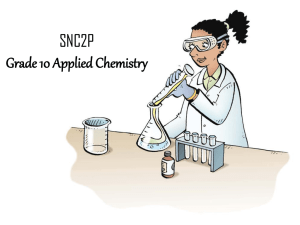Physical Science
advertisement
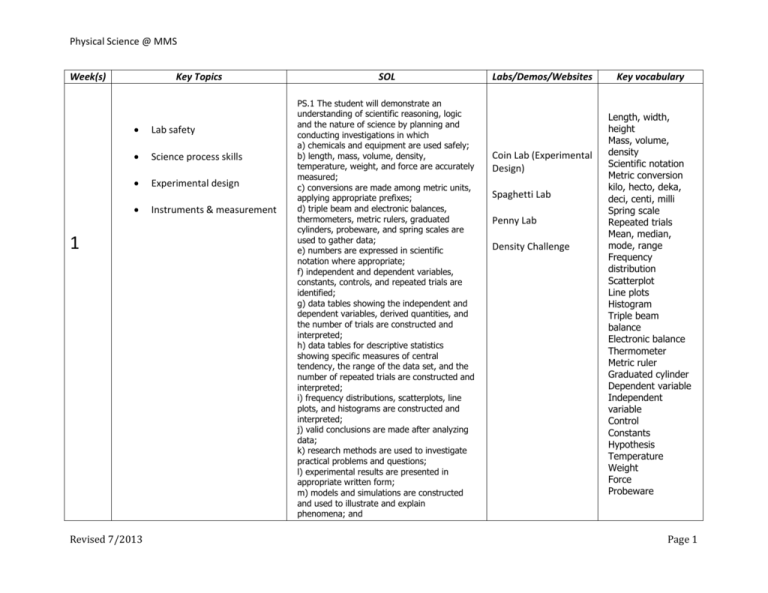
Physical Science @ MMS Week(s) Key Topics Lab safety Science process skills Experimental design 1 Revised 7/2013 Instruments & measurement SOL PS.1 The student will demonstrate an understanding of scientific reasoning, logic and the nature of science by planning and conducting investigations in which a) chemicals and equipment are used safely; b) length, mass, volume, density, temperature, weight, and force are accurately measured; c) conversions are made among metric units, applying appropriate prefixes; d) triple beam and electronic balances, thermometers, metric rulers, graduated cylinders, probeware, and spring scales are used to gather data; e) numbers are expressed in scientific notation where appropriate; f) independent and dependent variables, constants, controls, and repeated trials are identified; g) data tables showing the independent and dependent variables, derived quantities, and the number of trials are constructed and interpreted; h) data tables for descriptive statistics showing specific measures of central tendency, the range of the data set, and the number of repeated trials are constructed and interpreted; i) frequency distributions, scatterplots, line plots, and histograms are constructed and interpreted; j) valid conclusions are made after analyzing data; k) research methods are used to investigate practical problems and questions; l) experimental results are presented in appropriate written form; m) models and simulations are constructed and used to illustrate and explain phenomena; and Labs/Demos/Websites Coin Lab (Experimental Design) Spaghetti Lab Penny Lab Density Challenge Key vocabulary Length, width, height Mass, volume, density Scientific notation Metric conversion kilo, hecto, deka, deci, centi, milli Spring scale Repeated trials Mean, median, mode, range Frequency distribution Scatterplot Line plots Histogram Triple beam balance Electronic balance Thermometer Metric ruler Graduated cylinder Dependent variable Independent variable Control Constants Hypothesis Temperature Weight Force Probeware Page 1 Physical Science @ MMS n) current applications of physical science concepts are used. See PS.1 (Week 1) & 2 Metric system Mass vs. weight Work, Force, & Motion AND 3 Revised 7/2013 PS.10 The student will investigate and understand the scientific principles of work, force, and motion. Key concepts include a) speed, velocity, and acceleration; b) Newton’s laws of motion; c) work, force, mechanical advantage, efficiency, and power; and d) technological applications of work, force, and motion. “Do you feel the need for speed?” Newton’s Laws demonstrations (Newton’s rocker, inertia with mass/cart, bottle rocket launcher) Speed Acceleration Velocity Work Force Gravity Newton’s Laws of Motion Mechanical Advantage Efficiency Power Simple machines Compound machines Lever Pulley Wedge Screw Inclined plane Wheel and axle Wedge Page 2 Physical Science @ MMS 4 AND 5 6 States of energy Forms of energy Energy transformations Conservation of energy Heat Temperature scales Thermal Energy Transverse waves Longitudinal/compression waves Revised 7/2013 PS.6 The student will investigate and understand forms of energy and how energy is transferred and transformed. Key concepts include a) potential and kinetic energy; and b) mechanical, chemical, electrical, thermal, radiant, and nuclear energy. Energy of a Bouncing Ball lab Thermal expansion demo. PS.7 The student will investigate and understand temperature scales, heat, and thermal energy transfer. Key concepts include c) conduction, convection, and radiation; and d) applications of thermal energy transfer. PS.8 The student will investigate and understand the characteristics of sound waves. Key concepts include a) wavelength, frequency, speed, amplitude, rarefaction, and compression; b) resonance; Band students (pitch vs. volume) Tuning forks Watts Joules power = work ÷ time work = force x distance speed = distance ÷ time force = mass x acceleration Potential Energy Kinetic Energy Mechanical Energy Chemical Energy Electrical Energy Electromagnetic energy Thermal Energy Radiant Energy Nuclear Energy Energy Transformation or Conversion Conductors/insulators Radiation, conduction, and convection Temperature scales (°F, °C, and K) Absolute zero Phase changes Thermal expansion Wave Wavelength Frequency Amplitude Rarefaction Compression Page 3 Physical Science @ MMS AND 7 Sound Visible Light Electromagnetic Spectrum c) the nature of compression waves; and technological applications of sound PS.9 The student will investigate and understand the characteristics of transverse waves. Key concepts include a) wavelength, frequency, speed, amplitude, crest, and trough; b) the wave behavior of light; c) images formed by lenses and mirrors; d) the electromagnetic spectrum; and e) technological applications of light. Sound stations Dot mixer website Slinky Resonating straws Tacoma Narrows Bridge clip Slide shows on ES Reflection/refraction demo Concave, convex lenses 8 Electricity Magnetism AND 9 Revised 7/2013 PS.11 The student will investigate and understand basic principles of electricity and magnetism. Key concepts include a) static electricity, current electricity, and circuits; b) relationship between a magnetic field and an electric current; c) electromagnets, motors, and generators and their uses; and d) conductors, semiconductors, and insulators. Resonance Compression Wave Sonar Sound Transverse Wave Crest Trough Convex Lens Concave Lens Mirrors Electromagnetic Spectrum Radio/tv waves Microwaves Infrared rays Visible light Ultraviolet rays X-rays Gamma Rays Reflection Refraction Static electricity Series circuit Parallel circuit Direct current Magnets Alternating current Creating series/parallel Magnetic fields circuits Electromagnets Motors Electronic snap circuits Generators Resistors Conductor/insulator Conductors lab Semiconductors Insulators Blobz guide to electric Van de Graaff generator Page 4 Physical Science @ MMS circuits Law of Conservation of Matter and Energy Nature of Matter 10 11 PS.2 The student will investigate and understand the nature of matter. Key concepts include e) chemical properties; and f) characteristics of types of matter based on physical and chemical properties. Edible Mixtures PS.5 The student will investigate and understand changes in matter and the relationship of these changes to the Law of Conservation of Matter and Energy. Key concepts include a) physical changes; b) chemical changes; and c) nuclear reactions. Periodic table organization Atomic structure (modern and historical models) AND 12 Revised 7/2013 PS.3 The student will investigate and understand the modern and historical models of atomic structure. Key concepts include a) the contributions of Dalton, Thomson, Rutherford, and Bohr in understanding the atom; and b) the modern model of atomic structure. PS.4 The student will investigate and understand the organization and use of the periodic table of elements to obtain information. Key concepts include a) symbols, atomic numbers, atomic mass, chemical families (groups), and periods; b) classification of elements as metals, metalloids, and nonmetals; and c) formation of compounds through ionic and covalent bonding. The Power of the Periodic Table video Element Bingo Particle theory of matter Elements Compounds Mixtures States of matter Physical properties Chemical properties Absolute zero Physical changes Chemical changes Nuclear reactions Neutron Proton Electron Quark Atomic theory Symbol Atomic Number Atomic Mass Family or group Period Metal Nonmetal Metalloid Ionic Covalent Valence Electron Chemical Bond Periodic Table Alkali metal Alkaline earth metals Page 5 Physical Science @ MMS Transition metals Halogens Noble gases Balancing Chemical Equations Acids/Bases 13 PS.2 The student will investigate and understand the nature of matter. Key concepts include a) the particle theory of matter; b) elements, compounds, mixtures, acids, bases, and salts; c) solids, liquids, and gases; d) physical properties; e) chemical properties; and f) characteristics of types of matter based on physical and chemical properties. Testing pH of several common liquids pH Chemical Reaction Exothermic Endothermic Acids Bases Salts Neutral solutions Fusion Fission Coefficient Subscript PS.5 The student will investigate and understand changes in matter and the relationship of these changes to the Law of Conservation of Matter and Energy. Key concepts include a) physical changes; b) chemical changes; and c) nuclear reactions. LS.2 14 Cells Cellular organization Photosynthesis Populations Revised 7/2013 The student will investigate and understand that all living things are composed of cells. Key concepts include a) cell structure and organelles; b) similarities and differences between plant and animal cells; c) development of cell theory; and d) cell division. Cells/Genetics Relay Cells/Genetics Bingo Cell Tissue Organ System Cell cycle Cell wall Cell membrane Ribosomes Cytoplasm Endoplasmic reticulum Page 6 Physical Science @ MMS AND Ecosystems LS.3 The student will investigate and understand that living things show patterns of cellular organization. Key concepts include a) cells, tissues, organs, and systems; and b) patterns of cellular organization and their relationship to life processes in living things. LS.5 The student will investigate and understand the basic physical and chemical processes of photosynthesis and its importance to plant and animal life. Key concepts include a) energy transfer between sunlight and chlorophyll; b) transformation of water and carbon dioxide into sugar and oxygen; and c) photosynthesis as the foundation of virtually all food webs. LS.8 The student will investigate and understand interactions among populations in a biological community. Key concepts include a) the relationships among producers, consumers, and decomposers in food webs; b) the relationship between predators and prey; Genetics 15 Revised 7/2013 Vacuoles Chloroplast Cell theory Photosynthesis Glucose Oxygen Carbon dioxide Chlorophyll DNA Gene Chromosome Dominant Recessive Mendel Phenotype Genotype Punnett square Genetics Food chains Food webs Producers Consumers Decomposers Predator Prey Competition Cooperation Organism Population Community Ecosystem Symbiotic relationships Niche Page 7 Physical Science @ MMS c) competition and cooperation; d) symbiotic relationships; and e) niches. Revised 7/2013 LS.9 The student will investigate and understand how organisms adapt to biotic and abiotic factors in an ecosystem. Key concepts include a) differences between ecosystems and biomes; b) characteristics of land, marine, and freshwater ecosystems; and c) adaptations that enable organisms to survive within a specific ecosystem. LS.12 The student will investigate and understand that organisms reproduce and transmit genetic information to new generations. Key concepts include a) the structure and role of DNA; b) the function of genes and chromosomes; c) genotypes and phenotypes; d) characteristics that can and cannot be inherited; e) genetic engineering and its applications; and f) historical contributions and significance of discoveries related to genetics. Biotic factors Abiotic factors Biomes Page 8 Physical Science @ MMS Earth and Space Systems Water 6.8 The student will investigate and understand the organization of the solar system and the interactions among the various bodies that comprise it. Key concepts include a) the sun, moon, Earth, other planets and their moons, dwarf planets, meteors, asteroids, and comets; b) relative size of and distance between planets; c) the role of gravity; d) revolution and rotation; e) the mechanics of day and night and the phases of the moon; f) the unique properties of Earth as a planet; g) the relationship of Earth’s tilt and the seasons; h) the cause of tides; and the history and technology of space exploration. 6.5 The student will investigate and understand the unique properties and characteristics of water and its roles in the natural and human-made environment. Key concepts include a) water as the universal solvent; b) the properties of water in all three phases; c) the action of water in physical and chemical 16 AND 17 Revised 7/2013 Mercury Venus Earth Mars Jupiter Saturn Uranus Neptune (Pluto) Inner planets Outer planets Terrestrial Gas giants Rotation Revolution Solar system Moon phases Tides Seasons Universal solvent Physical weathering Chemical weathering Page 9 Physical Science @ MMS weathering; d) the ability of large bodies of water to store thermal energy and moderate climate; e) the importance of water for agriculture, power generation, and public health; and f) the importance of protecting and maintaining water resources. Revised 7/2013 Page 10

